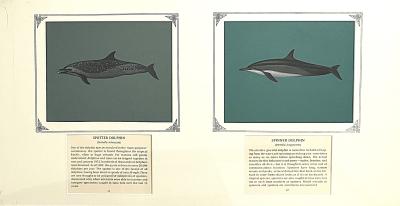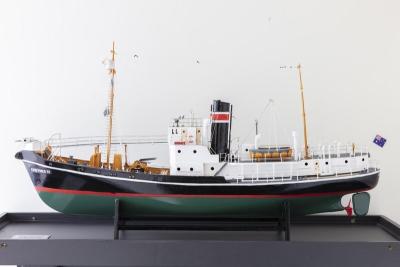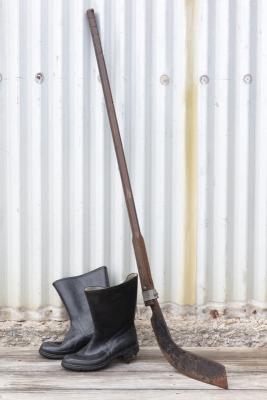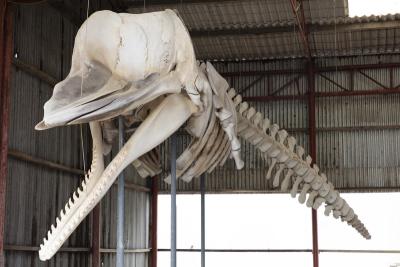PAINTINGS - (a)CLYMENE DOLPOHIN (b)ATLANTIC SPOTTED DOLPHIN
c. 19752 paintings in single framed work (a) Clymene dolphin - Streamline bodied dolphin with three-part color pattern- dark gray cape, light gray sides, and pale gray belly, with black-tipped beak and "mustache" marking (13) (b) Atlantic Spotted dolphin -Dark grey colored dolphin with lighter grey sides, white spotted, with distinct, curved dorsal fin (14); gouache on blue card, framed and mounted with inscription
Collection of 106 of paintings by Richard Ellis that were selected by the Smithsonian Institution to form a traveling exhibit of the marine mammals of the world. The collection was purchased by Perth businessman Kevin Parry in 1985 and donated to Whale World, now known as Albany's Historic Whaling Station.
These were originally framed with RE.1999.316 but have been split up & reframed.
Details
Details
CLYMENE DOLPHIN (Stenella clymene)
For many years the existence of a short-snouted spinner dolphin was suspected only in 1981, however, was the description of this species published. The clymene closely resembles the "long-snouted spinner," but has a somewhat different color pattern, particularly on the head, as well as a much shorter snout. It has been found in the tropical waters of the Atlantic, but may be even more widely distributed. Its averages only about 6 feet in length and weighs about 165 pounds when full-grown.
13.
ATLANTIC SPOTTED DOLPHIN (Stenella plagiodon)
Similar in shape and coloration to the Pacific spotter, this species is unspotted when young (often leading to confusion with the bottlenose), but develops the heavy pattern of spots as it matures. It is, then one of the few species of cetacean in which the color pattern changes from juvenile to adult. In the waters of the Caribbean, spotters have been known to approach divers- a most unusual behavior in these usually timid and wary animals. Except for the occasional encounters with swimmers, Atlantic spotters are poorly known, although they have occasionally been maintained in captivity in Florida and England.
14.
The paintings represent a body of work by well-known American marine conservationist, author, artist and natural historian Richard Ellis (1938-2024).
Copyright and Reference
Copyright and Reference
Albany's Historic Whaling Station
Albany's Historic Whaling Station
Other items by Richard Ellis
- PAINTING -BLACK DOLPHIN
- PAINTINGS - (a) CARIBBEAN MONK SEAL (b) HAWAIIAN MONK SEAL
- PAINTINGS - (a) BAIRD'S BEAKED WHALE (b) GOOSEBEAK WHALE
- PAINTINGS - (a)FRASER'S DOLPHIN & (b)WHITE BEAKED DOLPHIN
- PAINTING - ATLANTIC WHITE SIDED DOLPHIN
- PAINTING -NORTHERN FUR SEAL
- PAINTING - SEI WHALE
- PAINTING - SOUTHERN BOTTLENOSE WHALE
- PAINTINGS - (a)PYGMY SPERM WHALE (b)DWARF SPERM WHALE
- PAINTING -HECTOR'S DOLPHIN
- PAINTING - FINLESS PORPOISE
- PAINTING - HOURGLASS DOLPHIN
More items like this
- PAINTING - PACIFIC WHITE-SIDED DOLPHIN
- PAINTINGS - SPOTTER DOLPHIN (11) & SPINNER DOLPHIN (12)
- PAINTINGS (a) NORTHERN RIGHT DOLPHIN (b)SOUTHERN RIGHT DOLPHIN
- PAINTING - CHINESE RIVER DOLPHIN
- PAINTINGS - (a) DUSKY DOLPHIN & (b) PEALE'S DOLPHIN
- PAINTINGS - (a) WEST AFRICAN HUMPBACK DOLPHIN & (b) TUCUXI
- PAINTINGS - (a) GANGES RIVER DOLPHIN (b)INDUS RIVER DOLPHIN




